人教版七年级英语上册Unit1-A
- 格式:ppt
- 大小:4.30 MB
- 文档页数:21
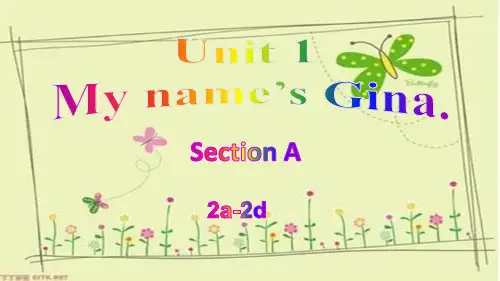
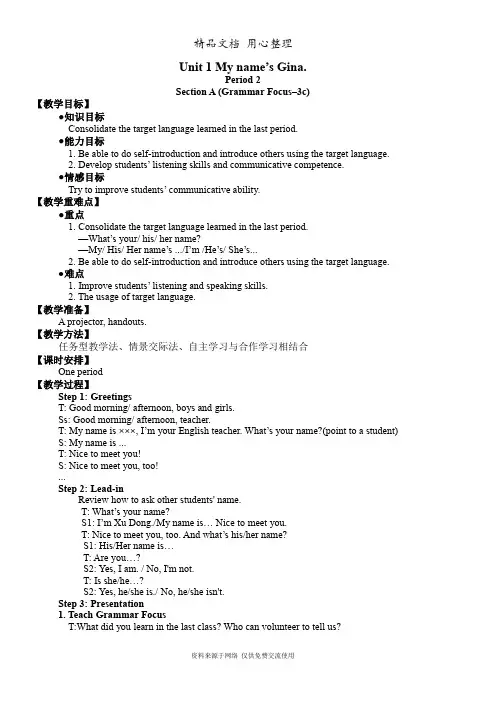
Unit 1 My name’s Gina.Period 2Section A (Grammar Focus–3c)【教学目标】●知识目标Consolidate the target language learned in the last period.●能力目标1. Be able to do self-introduction and introduce others using the target language.2. Develop students’ listening skills and communicative competence.●情感目标Try to improve students’ communicative ability.【教学重难点】●重点1. Consolidate the target language learned in the last period.—What’s your/ his/ her name?—My/ His/ Her name’s .../I’m /He’s/ She’s...2. Be able to do self-introduction and introduce others using the target language.●难点1. Improve students’ listening and speaking skills.2. The usage of target language.【教学准备】A projector, handouts.【教学方法】任务型教学法、情景交际法、自主学习与合作学习相结合【课时安排】One period【教学过程】Step 1: GreetingsT: Good morning/ afternoon, boys and girls.Ss: Good morning/ afternoon, teacher.T: My name is ×××, I’m your English teacher. What’s your name?(point to a student) S: My name is ...T: Nice to meet you!S: Nice to meet you, too!...Step 2: Lead-inReview how to ask other students' name.T: What’s your name?S1: I’m Xu Dong./My name is… Nice to meet you.T: Nice to meet you, too. And what’s his/her name?S1: His/Her name is…T: Are you…?S2: Yes, I am. / No, I'm not.T: Is she/he…?S2: Yes, he/she is./ No, he/she isn't.Step 3: Presentation1. Teach Grammar FocusT:What did you learn in the last class? Who can volunteer to tell us?S1:Me. We’ve learned how to introduce ourselves.S2:We’ve learned the use of verb be.S3:We’ve learned the possessive pronounces.T:Great! Today we’ll consolidate what we’ve learned in the last class.(1) Ask students to open their book, and turn to Page 3. Read through the sentences in the box.(2) Ask students to write down their answers to the questions, and substitute the names of the names of students in the box.(3) Leave students several minutes to do the task.(4) Collect their answers. Correct mistakes if there is any.(5) Ask students to read the short forms in the box. Pay attention to the pronunciation.2. Teach activity 3a(1) Look at 3a. Tell Ss to put the words in order to make conversations. Pay attention to theright sentence structure. Ss work with their partners. Try to make conversations with the given words.(2) Check the answers. Encourage some pairs to act out the dialogue. See if their dialogues are right.(3) Ss read the dialogue aloud after the teacher. Then try to practice the dialogues with their partners.(4) Let some pairs to act out the dialogue in front of the class.Step 4: Practice1. Teach activities 3b(1) Look at 3b. Tell Ss to complete conversation. Pay attention to the right sentence structure.Ss work with their partners. Try to make conversation.(2) Check the answers. Encourage some pairs to act out the conversations. See if their answers are right.(3) Ss read the conversations aloud after the teacher. Then try to practice the conversations with their partners.(4) Let some pairs to act out the conversations in front of the class.2. Teach activity 3c(1) Now, each of you has an English name. So we have learnt many names about boys and girls. Do you know how many foreign names? Let's do a "Name game".Competition: list names as many as possible, see which group gets the most names.(2) Divide the Ss into groups of six or more. Each group has four or six students.(3) Tell Ss how to play the game. Make a model for the Ss.S1: My name is Jenny.S2: Her name is Jenny. My name is Tony.S3: Her name is Jenny. His name is Tony…My name is June.S4: …(4) Ss play the game in their groups first. Then have a competition. See which group is the best.Step 5: ConsolidationSum up the possessive pronouns “my, your, his, her...”.Do exercises:1. What’s (你的) name?2. (我的) name is Jenny.= Jenny.3. What’s (他的) name?4. (他的) name is Tony.5. What’s (她的) name?6. (她的) name is Gina.Invite volunteers to present the answers.Answers:1.your 2. My; I’m 3.his 4.His 5.her 6.Her【课堂小结】In this period, we’ve consolidated what we’ve learned in the last period through some practice and games.【课后作业】1. Read the sentences in Grammar Focus.2. Make some conversations by yourself.。
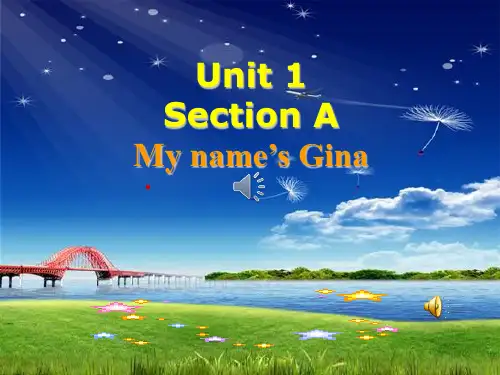
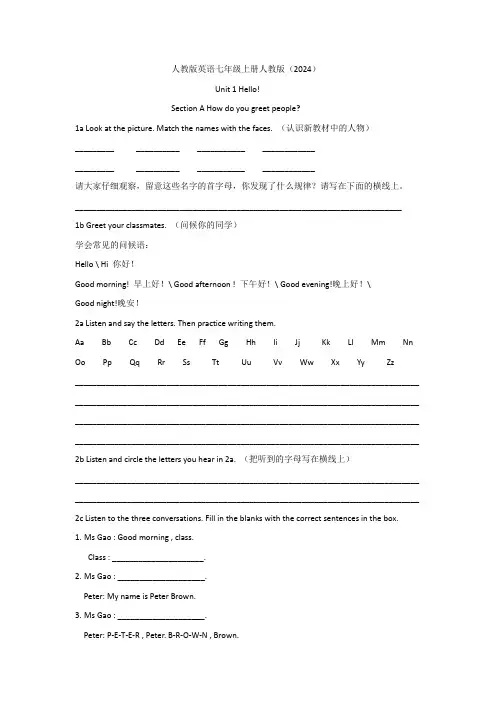
人教版英语七年级上册人教版(2024)Unit 1 Hello!Section A How do you greet people?1a Look at the picture. Match the names with the faces. (认识新教材中的人物)_________ __________ ___________ _____________________ __________ ___________ ____________请大家仔细观察,留意这些名字的首字母,你发现了什么规律?请写在下面的横线上。
___________________________________________________________________________1b Greet your classmates. (问候你的同学)学会常见的问候语:Hello \ Hi 你好!Good morning! 早上好!\ Good afternoon ! 下午好!\ Good evening!晚上好!\Good night!晚安!2a Listen and say the letters. Then practice writing them.Aa Bb Cc Dd Ee Ff Gg Hh Ii Jj Kk Ll Mm Nn Oo Pp Qq Rr Ss Tt Uu Vv Ww Xx Yy Zz_______________________________________________________________________________ _______________________________________________________________________________ _______________________________________________________________________________ _______________________________________________________________________________ 2b Listen and circle the letters you hear in 2a. (把听到的字母写在横线上)_______________________________________________________________________________ _______________________________________________________________________________ 2c Listen to the three conversations. Fill in the blanks with the correct sentences in the box.1.Ms Gao : Good morning , class.Class : _____________________.2.Ms Gao : ____________________.Peter: My name is Peter Brown.3.Ms Gao : ____________________.Peter: P-E-T-E-R , Peter. B-R-O-W-N , Brown.2d Make up a conversation to greet each other.A: Good morning.B: ____________________. What’s your name?A: ___________________________.B: How do you spell your name ?A: _____________________.B: Goodbye.A: ______________________.Pronunciation1 Listen to the 26 letters. Find then on the keyboard. Then practice with a partner. Where is A?A is here.2 Listen and repeat the letters.1./e ɪ / Aa Hh Jj Kk2./i:/ Bb Cc Dd Ee Gg Pp Tt Vv Zz3./e/ Ff Mm Nn Ss Xx Zz4./ai / Ii Yy5./ju:/ Qq Uu Ww6./əʊ/ Oo7./a:/ Rr3 Listen to these letters. Match them with the pictures.1.PLA _________________2.VR __________________3.CD __________________4.PRC ___________________5.UN ___________________4 Listen and sing the songA ,B ,C ,D ,E ,F ,G ,H , I , J , K , L , M , N ,O , P , Q , R , S , T .U , V , W , X , Y , Z.X , Y , Z —now you see ,I can say my ABCs.本部分知识点回顾:1、问候他人:一天的各个时间段遇见,用Good + 时间;例如:Good morning ! 早上好!\ Good afternoon ! 下午好!\ Good evening ! 晚上好!\ Good night ! 晚安!Hello , Hi 用于向他人问候。
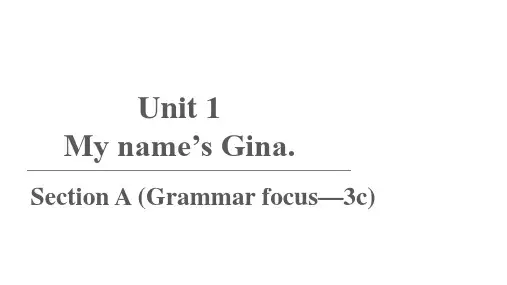
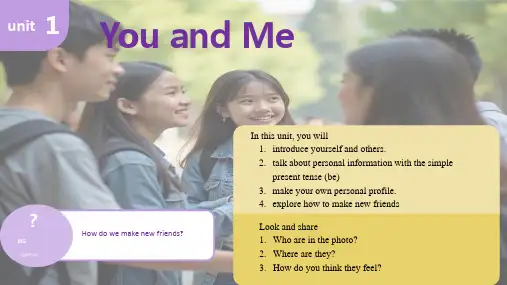
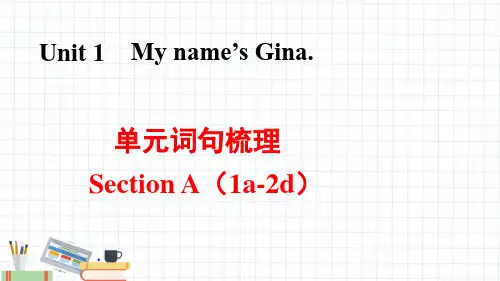
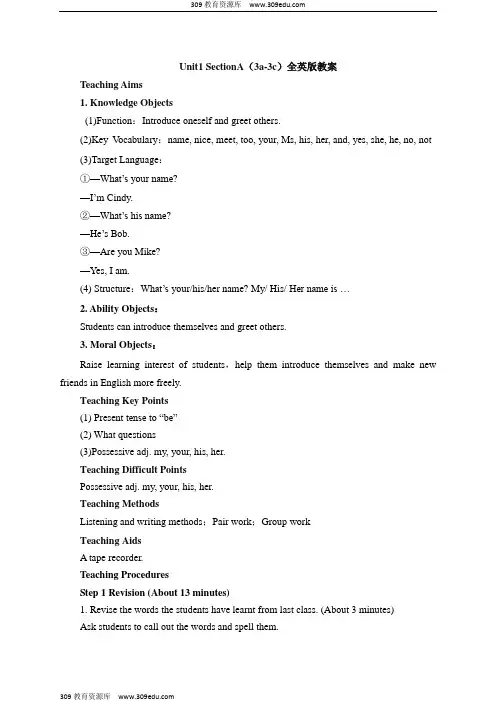
Unit1 SectionA(3a-3c)全英版教案Teaching Aims1. Knowledge Objects(1)Function:Introduce oneself and greet others.(2)Key V ocabulary:name, nice, meet, too, your, Ms, his, her, and, yes, she, he, no, not(3)Target Language:①—What’s your name?—I’m Cindy.②—Wha t’s his name?—He’s Bob.③—Are you Mike?—Yes, I am.(4) Structure:What’s your/his/her name? My/ His/ Her name is …2. Ability Objects:Students can introduce themselves and greet others.3. Moral Objects:Raise learning interest of students,help them introduce themselves and make new friends in English more freely.Teaching Key Points(1) Present tense to “be”(2) What questions(3)Possessive adj. my, your, his, her.Teaching Difficult PointsPossessive adj. my, your, his, her.Teaching MethodsListening and writing methods;Pair work;Group workTeaching AidsA tape recorder.Teaching ProceduresStep 1 Revision (About 13 minutes)1. Revise the words the students have learnt from last class. (About 3 minutes)Ask students to call out the words and spell them.Grammar Focus. (About 5 minutes)Check if they have remembered the possessive adjectives such as his, her, your and my.Role-play the conversation on P2 —2d. (About 5 minutes)Encourage students to practice the dialogue again, and let them create their own dialogues.Step 2 Activity 3a. Put the words in order to conversations. (About 6 minutes)1. Do it by themselves.2. Check the answers.3. Practice the conversations in pairs.Step 3 Pair work 3b (About 6 minutes)1. Complete it by oneself.2. Check the answers.3. Practice the conversation with your partner.Step 4 Name game 3c (About 8 minutes)Rules: Every student should introduce himself or herself, but at the name time he or she should repeat all the above-mentioned classmates’ names. The winners of the game wi ll get some prizes.Step 5 Test in this part (About 8 minutes)Step 6 Homework (About 4 minutes)Now you’ve known something about introductions and greetings. Try to imagine that you are in a new place, how do you introduce yourself and greet others? Please write a short dialogue about it.Blackboard DesignUnit 1 My name’s GinaThe Second Period (Section A 3a—3c)What’s= what is name’s=name is I’m = I amHe’s =he is she’s =she is。
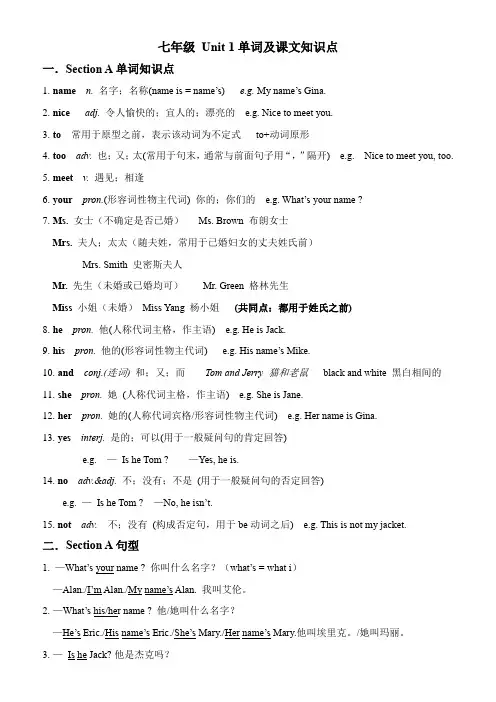
七年级Unit 1单词及课文知识点一.Section A单词知识点 n. 名字;名称(name is = name’s) e.g. My name’s Gina.2.nice adj.令人愉快的;宜人的;漂亮的 e.g. Nice to meet you.3.to常用于原型之前,表示该动词为不定式to+动词原形4.too adv.也;又;太(常用于句末,通常与前面句子用“,”隔开) e.g. Nice to meet you, too.5.meet v.遇见;相逢6.your pron.(形容词性物主代词) 你的;你们的 e.g. What’s your name ?7.Ms.女士(不确定是否已婚)Ms. Brown 布朗女士Mrs. 夫人;太太(随夫姓,常用于已婚妇女的丈夫姓氏前)Mrs. Smith 史密斯夫人Mr.先生(未婚或已婚均可)Mr. Green 格林先生Miss 小姐(未婚)Miss Yang 杨小姐(共同点:都用于姓氏之前)8.he pron.他(人称代词主格,作主语) e.g. He is Jack.9.his pron.他的(形容词性物主代词) e.g. His name’s Mike.10.and conj.(连词)和;又;而Tom and Jerry 猫和老鼠black and white 黑白相间的11.she pron.她(人称代词主格,作主语) e.g. She is Jane.12.her pron.她的(人称代词宾格/形容词性物主代词) e.g. Her name is Gina.13.yes interj.是的;可以(用于一般疑问句的肯定回答)e.g. —Is he Tom ? —Yes, he is.14. no adv.&adj.不;没有;不是(用于一般疑问句的否定回答)e.g. —Is he Tom ? —No, he isn’t.15. not adv. 不;没有(构成否定句,用于be动词之后) e.g. This is not my jacket.二.Section A句型1. —What’s your name ? 你叫什么名字?(what’s = what i)—Alan./I’m Alan./My name’s Alan. 我叫艾伦。
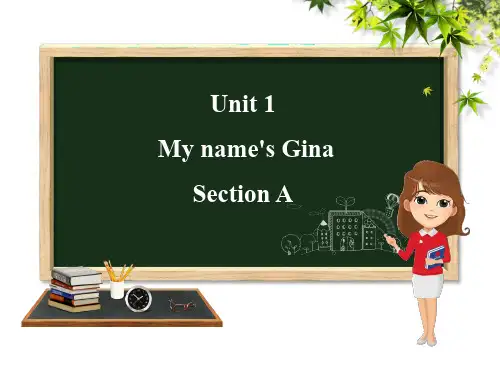
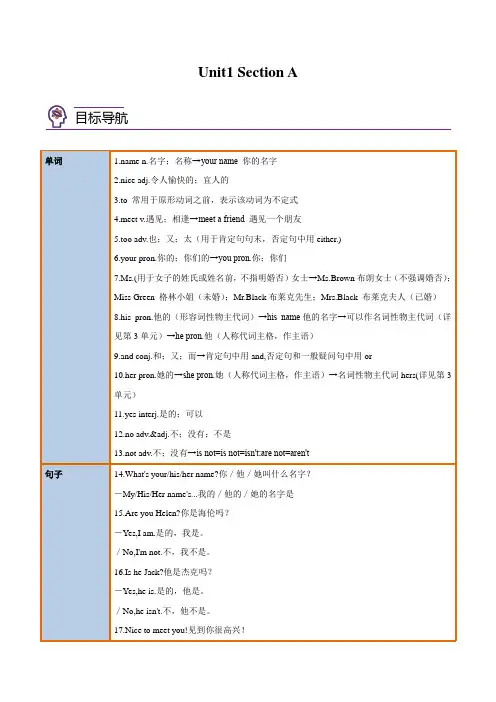
Unit1 Section A-Nice to meet you,too.见到你(我)也很高兴。
知识精讲知识点01 自我介绍的两种方法My name's...=I'm...我的名字叫·····(我是·····.)My name's是My name is的缩写形式,其中is是be动词的一种形式,用于第三人称单数作主语时。
I'm是I am的缩写形式,意为“我是/叫······”。
am意为“是”,是be动词的一种形式,只用于主语是I时。
am只能和I连用.类似缩写形式what's=what ishe's=he is不可以缩写的情况①this is不可以缩写。
②在肯定回答中,不可以缩写。
如“Yes,I am.”不可以缩写成“Yes,I'm.”。
My name's Lily. =I'm Lily.我叫莉莉。
-Hi.My name's Gina.I'm Jenny.My name's Alice.=My name is Alice.我叫艾丽斯。
【即学即练1】-My Linda. What's your name?-I Jack.s;ams;is's;am's;is答案C解析:第一空填name和is的缩写形式,第二空和I搭配的be是am。
拓展:are也是be动词的一种形式,用于主语是you或名词/代词复数时。
e.g.You are our friend.你是我们的朋友。
The jackets are red.这些夹克衫是红色的。
知识点02 my的用法my用作形容词性物主代词,意为“我的”,在句中作定语,后面必须跟名词。
联想助记my所对应的人称代词主格是1,意为“我”,在句中作主语。
Unit1 Section A〔1a-1c〕参考教案一、Teaching aims〔教学目标〕1.学会问候他人。
2.学会如何做自我介绍, 认识新朋友,并正确称呼他们的英文名字。
3.从对话中学会获取更多他人的根本信息。
5.初步学会使用局部形容词性物主代词。
二、Language points〔语言点〕1.要求掌握以下句式:〔1〕—What’s your name?—My name is…〔2〕—Hello! I’m Mary.—Hi, Mary! I’m Jim. Nice to meet you.〔3〕what’s =what is I’m =I am name’s =name is2.要求掌握以下词汇:〔1〕生词:name, clock, am, nice, meet, what, hello〔2〕人称代词和形容词性物主代词:I, you, my, your, his, her〔上述数词和局部形容词性物主代词本应在第二和第三课时中出现,但可以在第一课时中非正式出现,给学生初步的印象,为后面的学习作铺垫。
〕Difficulties〔难点〕:本课难点是大量的人名和形容词性物主代词,而学生在描述时容易混淆男名和女名,在运用代词时容易错用人称代词和物主代词。
三、Teaching steps〔教学步骤〕1. Warming-up and revision〔课堂热身和复习〕(1) Play the tape, enjoy the ABC song or Hello song, and get the Ss to sing together.1(2)Warm greetings to the students2T: Hello! / Hi!S: Hello! / Hi!T: You are very beautiful/cool/…S: Thank you.2. Presentation〔呈现新知识〕〔1〕T: Hello! My name is Lily. What’s your name? 3S: (引导学生答复) My name is Tom.T: It’s a good / nice name.4I like your name.〔2〕T: Hi! I’m Lily. / My name’s Lily.5S: (引导学生答复)Hi! Lily. I’m Alan.T: Nice to meet you! 5S: Nice to meet you!〔3〕Practice the expressions on the blackboard. Tell the Ss to pay attention to: what’s =what is I’m=I am name’s=name is3. Play a game. (Show the Ss a bag with fruits and two boxes full of English names.)6 T: Look here. I have a lot of gifts for you. Come here and touch.Try to say them in English, I’ll give you the gift and let you choose an English name first.S: Yeah.S1:(获得英文名后) My name’s…/ I’m…S(全班): Nice to meet you!S1: Nice to meet you!4. Work on 1a〔完成P1-1a〕T: Now look at the pictures on P1. Listen and Read. Try to say and write English words for the things in the picture. See how many words you know.T: Look here. What’s this? Who knows?〔Reward the student if she / he knows the word and write some new words on the blackboard to teach the Ss, such as clock…〕5.Work on 1b〔完成P1-1b〕T: Now let’s listen to the tape, find out the right conversation, and number them 1-3.8 〔Point out the boxes where students will write a number for each conversation. Play the recording for the first time, Ss only listen. Then play a second time, and Ssnumber the conversations.〕Dialogue 1: A: Hello! I’m Mary.B: Hi, Mary! I’m Jim.Dialogue 2: A: What’s your name?B: Alan.Dialogue 3: A: My name’s Jenny.B: I’m Gina. Nice to meet you!6.Work on 1c〔完成P1-1c〕〔1〕Ask the Ss to practice the conversations in 1b with a partner.〔2〕Encourage the Ss to leave their seats, move around and greet other classmates. 〔3〕Get some pairs to come to the front of the class andact out the dialogue after they have practiced several times.7.Follow up〔进一步扩展〕〔1〕〔Take out some photos of famous persons, such as athletes, film stars, singers and so on〕T: Well, I’d like to show you some pictures you are interested in. Can you tell me what her / his name is?What’s his / her name?Her / His name is…T: Great. / Wonderful. / Good. / Right. / Well done.〔Write down their names on the blackboard to make the Ss read more easily and remember more English names .〕〔2〕T: I’m sure you’ll be famous like them one day. So first you need to make a calling card.(Give each student an empty card for them to write their English names on one side and Chinese names on the other side, and then hang them before their chests.) 8.HomeworkOral work:(1) Listen to 1b, read and recite it. (听读背诵1b中的对话)(2) Go on making up your dialogues with your group members and polish it. (继续和小组成员编对话。